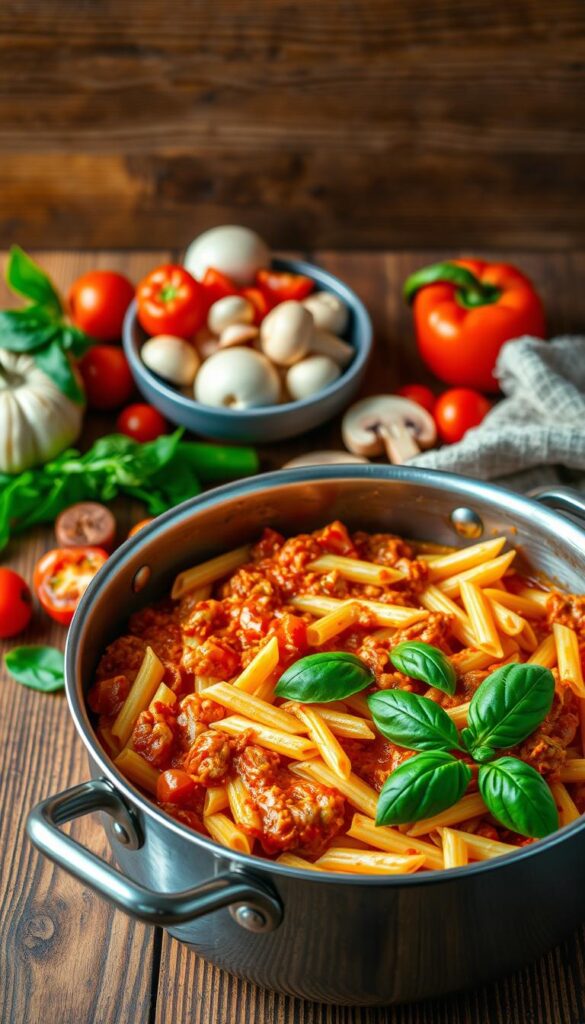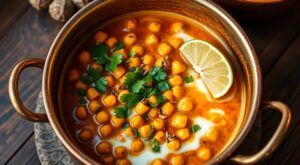Are you tired of spending hours in the kitchen, cooking and cleaning up after dinner? You’re not alone. Busy weeknights demand quick and easy solutions, and one pot pasta is here to save the day.
Cooking pasta in one pot with your favorite sauce and vegetables can be ready in just 20 minutes. This convenient meal solution not only saves time but also reduces cleanup to just one pot.
The best part? One pot pasta is not only quick but also packed with flavor. As the pasta cooks, it absorbs the delicious sauce, resulting in a rich and satisfying meal. Plus, this versatile cooking method works with various pasta types, sauces, and add-ins, so you can experiment with new recipes every night.
Key Takeaways
- Cooking one pot pasta meals is a quick and easy solution for busy weeknights.
- Ready in just 20 minutes, one pot pasta meals save you time.
- Cleanup is a breeze with only one pot to wash.
- One pot pasta meals are flavorful and versatile.
- You can experiment with various pasta types, sauces, and add-ins.
The Magic of One Pot Pasta Cooking
One pot pasta cooking is a game-changer for busy home cooks. You can save time and effort while still enjoying a delicious, homemade meal.
What Makes One Pot Pasta Special
One pot pasta cooking stands out due to its simplicity and efficiency. By cooking pasta, sauce, and other ingredients together in one pot, you reduce the complexity of meal preparation.
Time and Cleanup Benefits
Cooking one pot pasta meals can be done in just 20 minutes, a significant reduction compared to traditional pasta cooking methods that require boiling water, cooking pasta, and preparing sauce separately. This method not only saves you time but also reduces cleanup work, as you’re using fewer dishes and utensils. With one pot pasta, you can enjoy a quick, easy, and environmentally friendly meal that’s perfect for busy weeknights or when cooking facilities are limited.
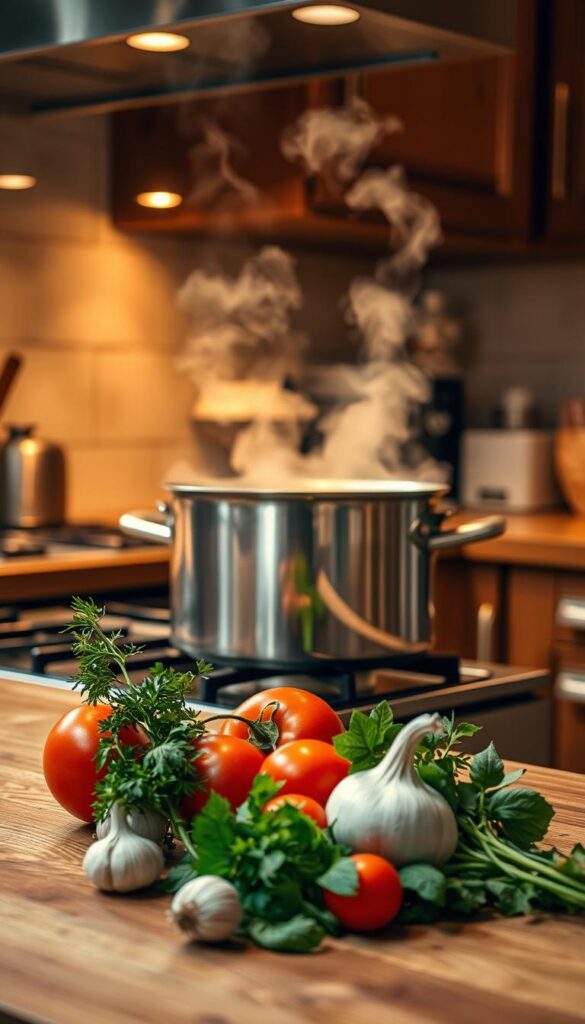
Essential Ingredients for Perfect One Pot Pasta Meals
To create perfect one pot pasta meals, it’s essential to understand the key ingredients that make them delicious. The beauty of one pot pasta lies in its simplicity, allowing you to combine a few fundamental components to create a satisfying meal.
Base Components: Pasta, Liquid, and Sauce
The foundation of any one pot pasta dish includes pasta, liquid, and sauce. You can use various types of pasta, but it’s crucial to choose shapes that cook evenly and quickly. The liquid can be broth, water, or a combination of both, and it’s essential to use enough to cook the pasta al dente. The sauce can be as simple as canned tomatoes or as rich as a homemade bechamel.
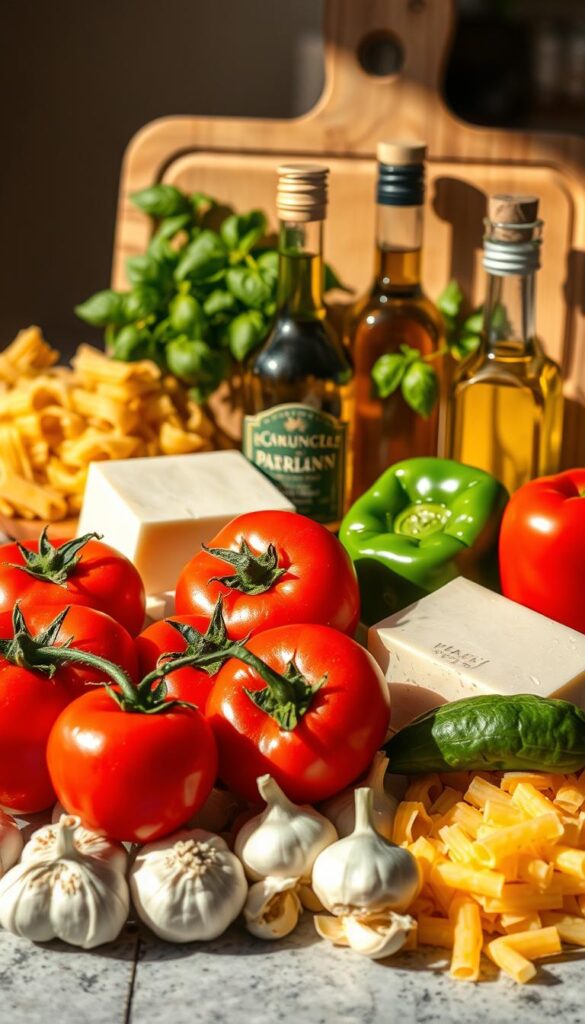
Flavor Enhancers: Aromatics and Seasonings
Aromatics like garlic and onion form the flavor foundation of most one pot pasta dishes. Sautéing these ingredients before adding other components develops a depth of flavor. Key seasonings include salt, pepper, Italian herbs, and red pepper flakes for added heat. Dried herbs work well when added early in cooking, while fresh herbs should be added towards the end. Acidic components like lemon juice or vinegar can brighten and balance the flavors.
Choosing the Right Pasta for One Pot Cooking
The key to a great one pot pasta dish lies in choosing the appropriate pasta shape and type. With so many varieties available, selecting the right one can make all the difference in your cooking experience.
Best Pasta Shapes for One Pot Meals
For one pot pasta cooking, it’s best to use shapes that allow for even cooking and good sauce distribution. Shapes like penne, fusilli, and farfalle work well because they have nooks and crannies that catch the sauce, ensuring every bite is flavorful. Shorter noodles like macaroni or rotini are also great options as they cook quickly and evenly.
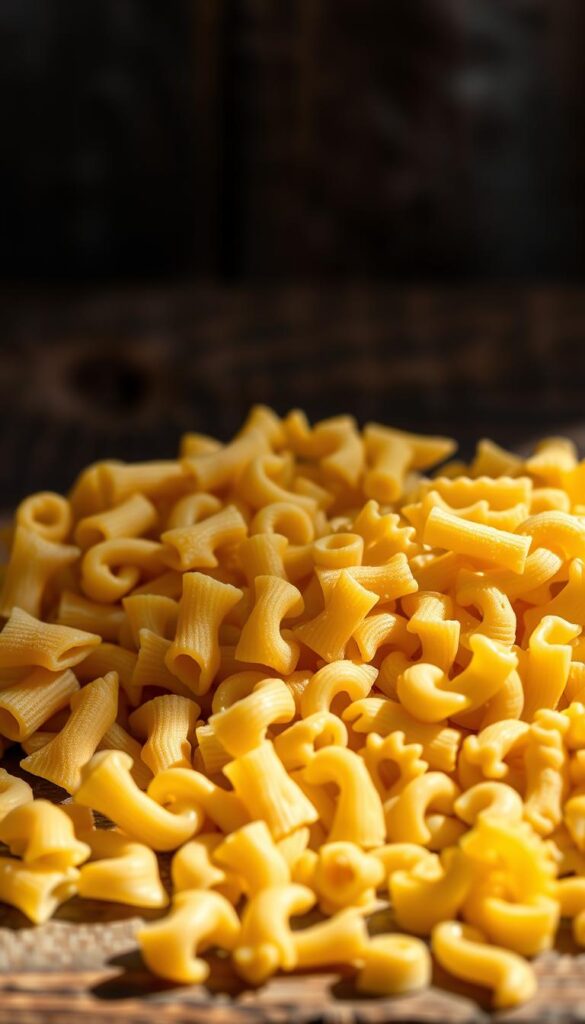
Regular vs. Gluten-Free Options
When it comes to choosing between regular and gluten-free pasta for one pot cooking, there are some differences to consider. Traditional wheat pasta generally cooks well in one pot recipes. However, gluten-free alternatives can behave differently. Brown rice pasta tends to work best among gluten-free options, while bean and lentil-based pasta can become gummy. Corn and grain blend pasta offer a middle ground in texture. For a successful gluten-free one pot recipe, you may need to adjust the liquid ratio and cooking time.
Basic One Pot Pasta Method: Step-by-Step Guide
To create a delicious one pot pasta dish, follow this simple step-by-step guide. One pot pasta cooking is all about combining the right ingredients and cooking them in a way that results in perfectly cooked pasta and a rich, flavorful sauce.
Preparing Your Ingredients
Before you start cooking, it’s essential to prepare your ingredients. This includes measuring out your pasta, sauce, and any additional ingredients like vegetables or protein. Make sure to chop any aromatics, such as onions and garlic, and have your seasonings ready.
The Cooking Process
Cooking one pot pasta involves combining your pasta, liquid, and sauce in a large pot. Bring the mixture to a boil, then reduce the heat to a simmer. Let it cook for the recommended minutes, usually between 8-12 minutes, depending on the type of pasta you’re using. Stir occasionally to prevent the pasta from sticking together.
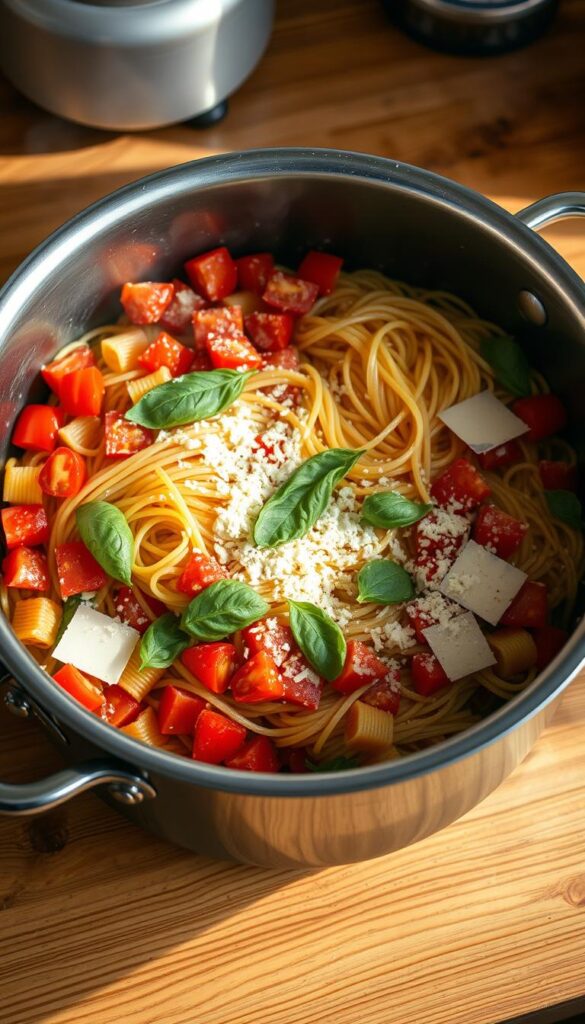
How to Know When It’s Done
Determining when your one pot pasta is done can be a bit tricky. The sauce should have thickened and coated the pasta evenly. To check if the pasta is cooked, test it for doneness by tasting. It should be al dente, with a slight resistance to the bite. You can also check the consistency of the sauce; it should not be too watery or too dry.
| Indicator | Description |
|---|---|
| Pasta Doneness | Al dente texture with slight resistance |
| Sauce Consistency | Coats pasta without being too watery or dry |
| Cooking Time | Usually between 8-12 minutes |
Delicious One Pot Pasta Recipes to Try
Simplify your cooking routine with our top one pot pasta recipes. One pot pasta is a game-changer for busy weeknights, offering a quick, delicious, and easy-to-clean-up meal solution.
Classic Tomato and Vegetable One Pot Pasta
This recipe is a staple for a reason. With pasta, fresh vegetables, and a rich tomato sauce, it’s a well-rounded meal that’s ready in under 30 minutes. Simply sauté your vegetables, add in your pasta and tomato sauce, and let it all cook together in one pot.

Creamy One Pot Mushroom Pasta
For a richer, creamier option, try our one pot mushroom pasta. This recipe combines sautéed mushrooms with garlic, pasta, and a creamy sauce all cooked in one pot. It’s a comforting dish perfect for a chilly evening.
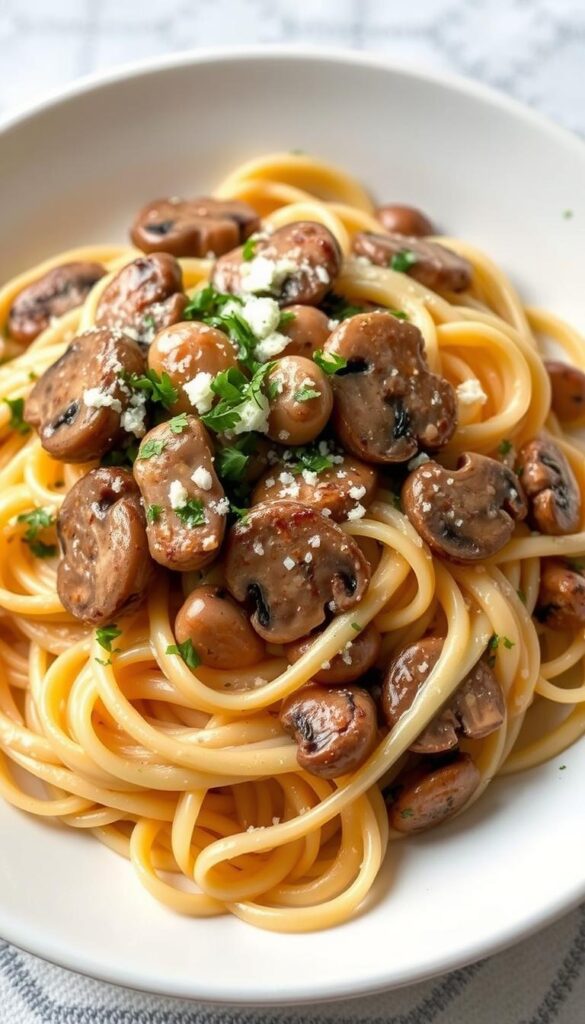
Simple One Pot Meat Sauce Pasta
Our simple one pot meat sauce pasta recipe is a hearty option that combines ground meat, pasta, and a flavorful meat sauce. By browning the meat before adding the other ingredients, you create a depth of flavor that infuses the entire dish.
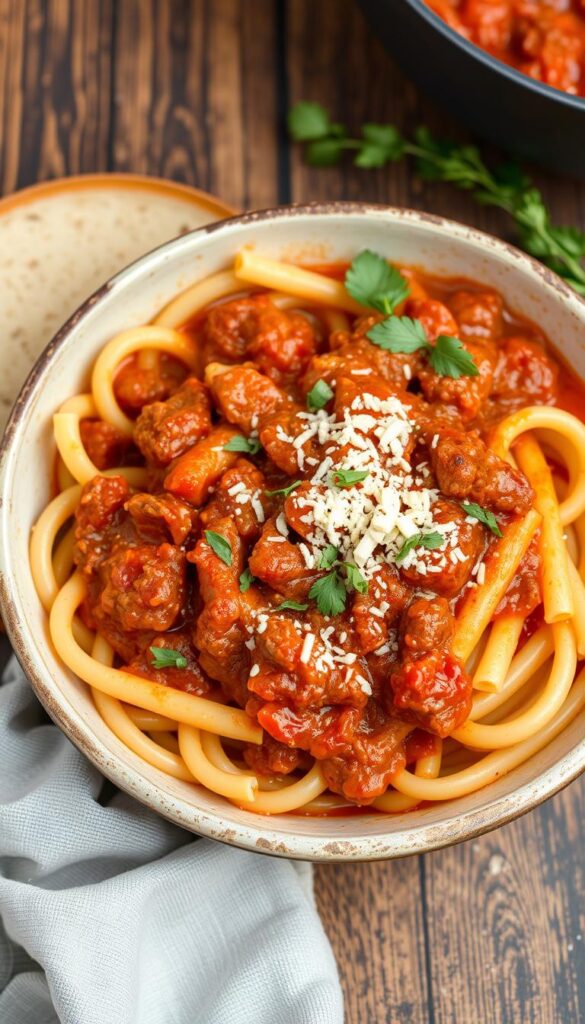
These one pot pasta recipes are not only delicious but also versatile. Feel free to experiment with different ingredients and sauces to create your own unique recipe.
Customizing Your One Pot Pasta Meals
You can easily personalize your one pot pasta meals by incorporating different vegetables, proteins, and seasonings. This flexibility is one of the key advantages of one pot cooking, allowing you to create a variety of dishes that cater to different tastes and dietary needs.
Vegetable Add-ins and Substitutions
Vegetables can greatly enhance the flavor and nutritional value of your one pot pasta. Consider adding vegetables like spinach, bell peppers, or mushrooms to create a hearty meal. You can also substitute different vegetables based on what’s in season or your personal preferences. For instance, broccoli and zucchini are excellent alternatives to traditional choices.
Protein Options to Boost Your Meal
Adding protein to your one pot pasta can make it more satisfying and filling. You have several options to choose from, including ground meat, chicken, shrimp, and canned beans. When incorporating protein, it’s essential to cook it properly to avoid overcooking the pasta. For example, browning ground meat before adding the pasta can add rich flavor, while sautéing shrimp towards the end of cooking prevents them from becoming tough. Canned beans can be added directly to the pot, making it a convenient option.
Different proteins affect the liquid requirements of your dish. For instance, some proteins like chicken or sausage release moisture during cooking, while others like shrimp absorb it. Adjusting the liquid accordingly ensures your pasta is cooked to perfection. Combining protein with pasta creates a balanced meal; for example, pairing chicken with penne or shrimp with linguine works well.
Pro Tips for One Pot Pasta Success
To master one pot pasta cooking, it’s essential to understand a few key techniques. One pot pasta is a versatile and convenient meal option that can be customized to suit any taste. By following some simple guidelines, you can achieve perfectly cooked pasta every time.
Perfecting the Pasta-to-Liquid Ratio
The key to successful one pot pasta cooking lies in achieving the right pasta-to-liquid ratio. Generally, you should use about 4 cups of liquid for every 1 cup of pasta. However, this can vary depending on the type of pasta and sauce you’re using. A good rule of thumb is to have the liquid level about 1-2 inches above the pasta. This ensures that your pasta cooks evenly and that you have a rich, creamy sauce at the end.
Stirring Techniques to Prevent Sticking
Stirring is a crucial step in one pot pasta cooking. To prevent your pasta from sticking to the pot or to itself, stir the mixture every 2-3 minutes. Using the right utensils can make a difference; a silicone spatula is often preferred over a wooden spoon because it’s gentler on the pot and more effective at scraping the bottom. Make sure to stir in a pattern that moves the pasta from the bottom to the top, ensuring even cooking and sauce distribution.
| Stirring Frequency | Result |
|---|---|
| Every 2-3 minutes | Evenly cooked pasta, creamy sauce |
| Less than every 2 minutes | Pasta may stick together or to the pot |
| More than every 3 minutes | Risk of undercooked or overcooked pasta |
Troubleshooting Common One Pot Pasta Problems
Making one pot pasta can be a breeze, but knowing how to troubleshoot is key. Even with the best recipe, things can go wrong. Whether it’s undercooked pasta or a sauce that’s too thin, we’ve got the solutions you need.
Dealing with Undercooked or Overcooked Pasta
If your pasta is undercooked, simply add a bit more liquid and continue cooking until it reaches your desired texture. On the other hand, if it’s overcooked, there’s not much you can do to reverse it, but you can prevent it by checking the pasta frequently towards the end of cooking time.
Fixing Sauce Consistency Issues
Sauce consistency can make or break your one pot pasta dish. If your sauce is too watery, try simmering it uncovered for a few minutes to reduce the liquid. Alternatively, you can add a small amount of cornstarch slurry to thicken it. If the sauce is too thick, you can thin it out by adding small amounts of hot broth or water.
The heat level during cooking can significantly affect the sauce consistency. Cooking on high heat can cause the sauce to thicken too quickly, while low heat might result in a sauce that’s too thin. Additionally, different types of pasta release varying amounts of starch, which impacts the sauce’s thickness. To achieve the perfect consistency, it’s crucial to balance the pasta type with the right cooking time and heat level.
| Issue | Solution |
|---|---|
| Watery Sauce | Simmer uncovered or add cornstarch slurry |
| Thick Sauce | Add hot broth or water |
| Undercooked Pasta | Add more liquid and continue cooking |
Storing and Reheating Your One Pot Pasta Creations
Storing and reheating one pot pasta is a straightforward process that ensures you enjoy your meal for days. Proper storage is key to maintaining the quality of your one pot pasta. After cooking, let it cool down to room temperature to prevent condensation inside the storage container, which can make the pasta soggy.
Once cooled, transfer your one pot pasta to an airtight container. This one pot pasta will keep in the fridge for up to 5 days. The type of pasta and sauce used can affect how well the dish stores. For instance, creamy sauces tend to thicken when refrigerated, while tomato-based sauces generally retain their flavor and texture well.
When you’re ready to reheat, you have a couple of options. You can mix the pasta with a few tablespoons of water, cover it, and microwave on medium power for a few minutes. Alternatively, reheating it in a pan on the stove over medium heat, stirring occasionally, can help restore its original flavor and texture. Adding a bit of water or sauce during reheating can prevent the pasta from drying out.
Interestingly, one pot pasta often tastes even better the next day as the flavors continue to meld together. You can also refresh your leftover pasta by adding some fresh herbs, vegetables, or a sprinkle of parmesan cheese, making it a versatile meal option.
By following these simple storage and reheating tips, you can enjoy your one pot pasta creations for days, making it a convenient and satisfying meal solution.
Conclusion
Mastering one pot pasta cooking is a game-changer for home cooks. This technique offers numerous benefits, including time-saving, fewer dishes, and delicious results.
By following the principles outlined in this article, you can create your own one pot pasta creations tailored to your taste preferences and dietary needs. Whether you’re looking for a quick meal solution or wanting to experiment with new recipes, one pot pasta is a versatile option.
In just a few minutes, you can have a satisfying meal on the table. We encourage you to share your one pot pasta successes and variations, and with practice, this technique will become a go-to solution in your kitchen.
FAQ
How long can I store one pot pasta in the fridge?
You can keep your one pot pasta in the fridge for up to 3-4 days. Make sure to store it in an airtight container and reheat it to an internal temperature of 165°F (74°C) before consumption.
Can I use gluten-free pasta for one pot cooking?
Yes, you can use gluten-free pasta for one pot cooking. However, keep in mind that gluten-free pasta may have a different cooking time, so adjust the liquid ratio and cooking time accordingly.
How do I prevent my one pot pasta from becoming mushy?
To prevent mushy pasta, use the right pasta shape, monitor the cooking time, and maintain the correct pasta-to-liquid ratio. You can also stir the pasta occasionally during cooking to prevent it from sticking together.
Can I add protein like chicken or sausage to my one pot pasta?
Absolutely! You can add protein sources like chicken, sausage, or bacon to your one pot pasta. Just cook the protein until it’s browned and cooked through before adding the pasta and liquid.
How much liquid should I use for one pot pasta cooking?
The general rule of thumb is to use 4 cups of liquid (water or broth) for every 12 ounces of pasta. However, this ratio may vary depending on the type of pasta, sauce, and desired consistency.
Can I customize one pot pasta recipes to suit my dietary preferences?
Yes, you can customize one pot pasta recipes to suit your dietary needs. Feel free to swap out ingredients, add your favorite vegetables, or use different seasonings to make the dish your own.
